Last week we looked at a really complicated (and interesting!) revolt against the Zanzibar Sultanate in 1888 Pangani, Tanzania. The revolt featured three different factions: the independents, who wanted total separation from the Sultanate; the autonomy faction, which wanted to reduce Zanzibari authority over Pangani and restore the privileges of the local elites; and the reconciliation faction that wanted the Zanzibar Sultanate to take back over, like things were before the revolt. This week, we’re going to look at six important power-players: two from each of the three factions. They make phenomenal NPCs for any political adventure!
This post is brought to you by beloved Patreon backer Arthur Brown. Thanks for helping keep the lights on! If you want to help keep this blog going alongside Arthur, head over to the Patreon page – and thank you!
We’ll start out with the independents. We know few of their names. This faction skewed poor; before the revolt these were mostly the people on the bottom of the political hierarchy. They left few written records and didn’t interact much with the Zanzibari and European envoys whose recollections we must partly depend on. Nonetheless, this was the most powerful faction, for it was by far the largest and fielded the most rifles.
One influential independent whose name we know was Semboja of Mazinde, a powerful trader and politician from a cadet branch of the royal family of the Kingdom of Shambaa. This kingdom lay along the trade routes between Pangani and the interior. Semboja grew wealthy as a middleman in the ivory and slave trade. He used his money to buy guns, and his well-armed followers dominated the countryside. Semboja was so influential that the power center of Shambaa moved from the capital to Semboja’s base at Mazinde. This was despite the fact that, as a scion of an insignificant branch of the royal line, Semboja had no access to the rain charms that granted Shambaa kings legitimacy.
Semboja saw himself as a cosmopolitan sultan. He wore Arab fashions. His palace was decorated with Western knickknacks: fine furniture and a painting of a locomotive. He had a prodigious appetite for liquor, which he had to buy from the coast. Anyone from outside Shambaa who passed through his sphere of influence had to give him gifts, preferably fancy things from abroad.
Semboja’s relations with the coastal elites were complex. He cared not a whit for the Sultanate of Zanzibar, whose officials almost never interacted with him until the late 1880s. The Shirazis – the Swahili-speaking traditional elites of the coastal trading cities – were on friendly terms with Semboja, but only when they had something to offer him. When Semboja learned Pangani was on the cusp of revolution, he saw an opportunity to claim the town for himself. He sent thousands of his followers to Pangani, where they formed an important part of the independence faction. An independent Pangani might be open to Semboja’s influence. Maybe someday he might add the town to his domain.
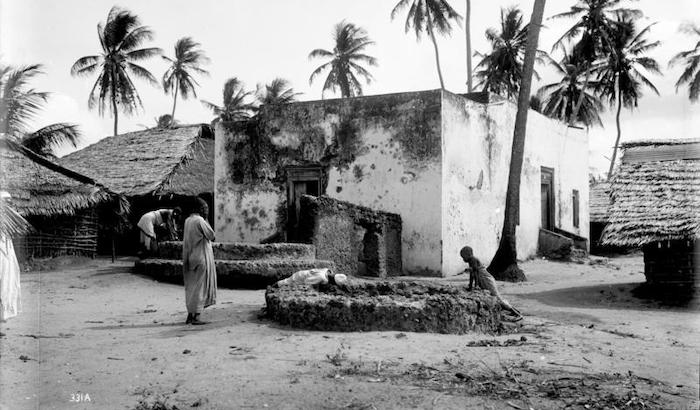
Credit: Bundesarchiv, Bild 105-DOA0331 / Walther Dobbertin / Released under a CC BY-SA 3.0 DE license.
Our other independence leader is Jahazi, a remarkable man. He was born in the Comoro Islands. It’s unclear in which order he did the following, but he learned the West African patois of English (spoken on the the other side of the continent), learned the little cultural tricks that help you interact with Europeans, and worked for Henry Stanley on one of the Welsh-American explorer’s trips into the Congo. Under Stanley, Jahazi became familiar with the latest European weaponry. When he appeared on the scene in Pangani, Jahazi was carrying a Mauser rifle – not available in local arms markets. He wore a European uniform, perhaps stolen or purchased from a European’s servant. As an outsider, Jahazi had no reason to back the Sultanate or the Shirazis, neither of whom had ever done anything for him. But in the new social order the independents were building, Jahazi’s skills made him a man of influence, and he pops up here and there as a sort of mid-rank officer.
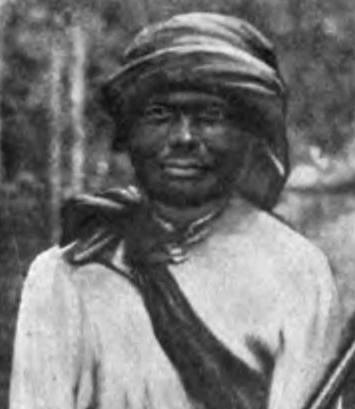
Next we move to the autonomy faction: the people who felt that the Sultanate of Zanzibar should retain some authority over Pangani, but that its power should be reduced and traditional authority returned to local leaders. The autonomy faction was helmed by Shirazis, a sort of hereditary Swahili social class that historically had a lot of wealth and influence, but had been watching that decline in recent years. The Shirazis were backed up by a cross-section of Pangani, with everyone from a handful of Arab planters to many enslaved people, who’d earlier enjoyed the promise of upward mobility under Shirazi rule.
Our first autonomy faction power-player, Kimemeta, was a community leader (a jumbe), an Islamic scholar, a seasoned leader of trading expeditions into the hinterlands, and a ritual healer. His healing and his scholarship made him a particularly well-regarded caravan leader. Religious rites were scrupulously observed on the march; these expeditions were risky enough without angering God. But Kimemeta was up to his eyeballs in debt to Indian merchants. He’d had to borrow money for his last few trading expeditions, and the trips hadn’t paid off. In 1886, Kimemeta was summoned to the Sultan’s court in Zanzibar to work out an arrangement. Whatever compromise or payment plan they’d reached didn’t work out, because a few weeks later in Pangani, Zanzibari officials threw him in jail for debt. Late in 1887, Kimemeta managed to scrape together enough money for a partial payment and was released. He organized more caravans in the hopes of making enough to pay it all off.
When the German East Africa Company (the DOAG, a handful of malcontents) started looking to lay claim to the hinterlands inland of the Swahili Coast, Kimemeta was one of the people the Sultanate marshaled to oppose German claims. Kimemeta led expeditions to talk to inland chiefs and convince them they shouldn’t do business with the DOAG. Once, coming upon a German station whose two occupants had gotten sick and left, Kimemeta burned the station house down. The jumbe didn’t do these things out of love for Zanzibar, but because he feared that if the DOAG ramped up its activities in the hinterlands, the Sultanate would have to do the same. Kimemeta and the other Shirazis made money because the Sultanate didn’t directly participate in the caravan trade – that was the Shirazis’ role. The DOAG was threatening to provoke the Sultanate into spoiling Kimemeta’s livelihood.
When Pangani revolted, the autonomy faction was clearly the right choice for Kimemeta. A weakened Sultanate wouldn’t be able to throw him in jail, nor would it be able to field trading expeditions to compete with his. But Kimemeta didn’t want the Sultanate out completely. Their status as overlords kept things stable and quiet on the coast, and stable was good for business. Kimemeta survived the brutal German suppression of the revolt a year later, but so did his debts. In 1890, he returned from a successful inland expedition only for the governor to order his entire haul seized to pay his debt to the merchants. The bosses were new, but the systems they enforced were unchanged.

Our other autonomy faction leader, Bushiri bin Salim, was a highborn folk hero. This whole revolt, up and down the Swahili coast, was historically called ‘the Bushiri War’, and an epic about his exploits is an important historical source on the revolt. Bushiri wasn’t a Shirazi. On his father’s line, he was an Arab, from the al-Harthi clan in Oman. The al-Harthis had been in Zanzibar for some time before the current royal family showed up, and had picked up Swahili customs. Bushiri’s mother was African and possibly enslaved. He was dark-skinned and his Swahili was better than his Arabic, for which foreign-born Arabs looked down on him. The al-Harthis were not in favor with the royal family, but Bushiri didn’t mind. As a young man, he’d made a fortune leading trading expeditions. He’d also led Zanzibari soldiers into battle. But Bushiri suffered an unknown falling out with the Sultanate. He was safe on the mainland, but if he ever returned to Zanzibar he’d be arrested. At the time of the revolt, Bushiri was 55 years old, rich, and charismatic. Everyone in Pangani owed him a favor. He was an aristocrat, a blueblood to the core, with a cultivated bearing and speech and a disdain for his social inferiors. He even beat Jahazi with a whip once for interrupting him.
When unrest began at Pangani, Bushiri was among the first to organize his followers. He used his considerable charisma and political capital to influence the other two factions. He pressured the reconciliation ‘peace party’ faction into staying mostly silent. He charmed the independence faction into taking prisoners rather than executing people. Bushiri didn’t want the Zanzibaris gone, just defanged, and ideally with him as their governor in Pangani. This put him in direct conflict with Semboja of Mazinde, who wanted to add Pangani to his sphere of influence; the two men hated one another.
Bushiri’s power in Pangani started to decline when he spent a lot of his political capital keeping the independents from executing a British representative. (Most folks didn’t draw a distinction between the British and the Germans.) The independents gradually became less willing to listen to him. Finding his influence over the largest and most dangerous faction waning, Bushiri announced he and his followers were going to take the fight to the Germans. They left Pangani. While on campaign, Bushiri maintained an ostentatious standard of living – he even took his harem with him! His aristocratic hauteur was a bad fit for living among rebels. Late in the war he was betrayed to the Germans, dragged back to Pangani, and hanged.
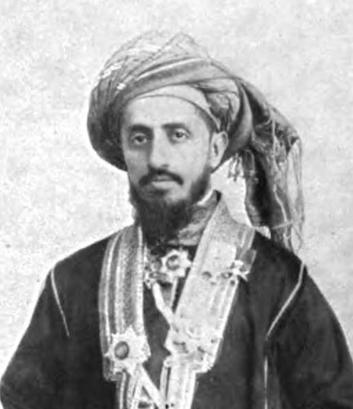
The primary leader of the reconciliation faction – the party that wanted a return to the status quo before the revolt – was Suleiman bin Nasr al-Lenki, one of the wealthiest Arab planters in Pangani. He was ostensibly working for the Sultanate, but started collaborating with the DOAG as soon as unrest began, and within a month they regarded him as their “direct agent”. He fled Pangani when the revolt started, around the same time that Pangani’s German and Zanzibari governors fled. The Sultanate soon appointed Suleiman to take their place. Shortly after his return to Pangani, the independents took him prisoner. He was then released, but his position was tenuous. He could sometimes convince the autonomy faction not to take sudden action, and hope that the charming Bushiri would keep the independents from doing the same. The independents permitted Suleiman to keep a contingent of Zanzibari soldiers with him, which meant he could show up in specific places and command a little respect, but his authority reached no farther than the range of the rifles of his bodyguards.
Bushiri’s departure from Pangani coincided with the departure of many independents to work on trading caravans. The independents still had far and away the most guns in Pangani, but Suleiman had fewer constraints on him than before. He was able to travel to Zanzibar, where he intimated that with a little military assistance, he could bring the independents to heel. He made multiple trips to Zanzibar for planning meetings. But on one of them, he suddenly found himself unable to return! While his boat was approaching Pangani, the independents opened fire on him. He had to go back to Zanzibar and wait for the arrival of German troops. After the massacre that put down the revolt, Suleiman went on to a prosperous career as an administrator in German East Africa.

Our final power-player is a retired British naval lieutenant named Lloyd Matthews. Matthews was the commander of the Zanzibari military and a trusted advisor to the previous sultan. It’s unclear how much influence he had over the sultan who ruled during the revolt. General Matthews replaced the Sultanate’s contingent of mercenaries with 1,300 regular soldiers, mostly recruited from the interior beyond the Swahili coast. Remember the trips Kimemeta made to convince inland chiefs not to work with the DOAG? Matthews led those expeditions. He also led the group that delivered Suleiman to Pangani as governor, though Matthews’ negotiations in Pangani were short-lived and the independents soon asked him to leave. Despite his best efforts, Matthews played little role in the revolt, but he’s still interesting as a fish out of water.
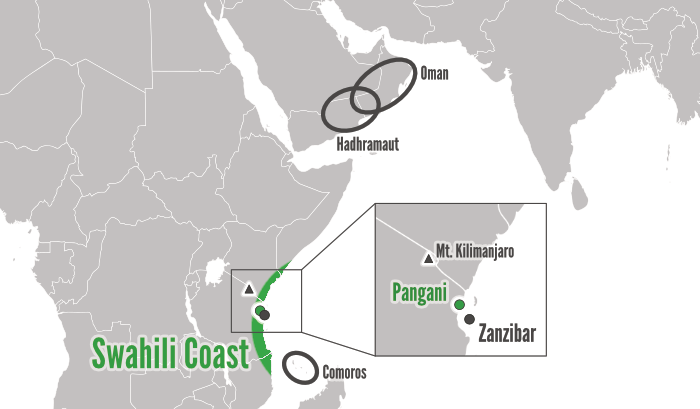
If you file the serial numbers off of them, these six NPCs make great power-players for whatever political adventure you’re preparing. They all have memorable and unique personality quirks, from Semboja’s appetite for liquor to Bushiri’s hauteur. They have cool backstories that impact the way PCs might interact with them, from Jahazi’s diverse professional experiences to Matthews’ status as a fish out of water. And they all have unique problems the PCs might be able to help them with, from Kimemeta’s crushing debt to Suleiman’s lack of reach. You can even mix and match attributes from different people to make exactly the right NPC your political dust-up needs!
Have you heard about Ballad Hunters, my upcoming RPG about singing and fighting magical folk ballads in 1813 England and Scotland? The early access version of the game is free. Check it out!
Source: Feasts and Riots: Revelry, Rebellion, and Popular Consciousness on the Swahili Coast, 1856-1888 by Jonathon Glassman (1995)







